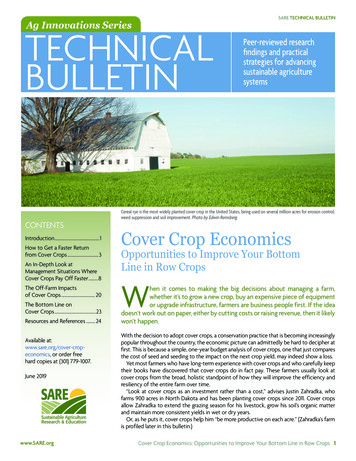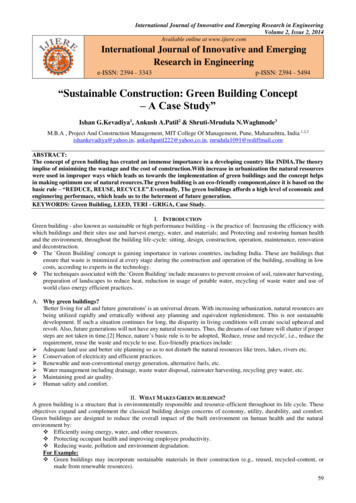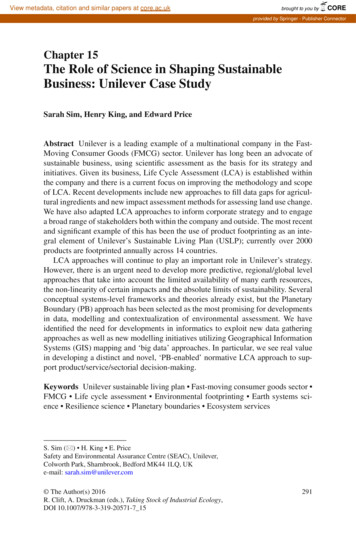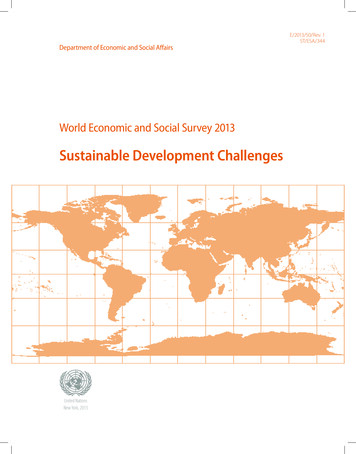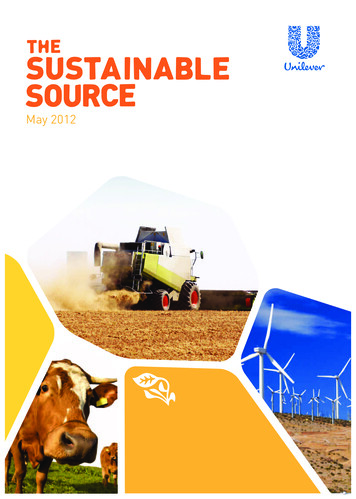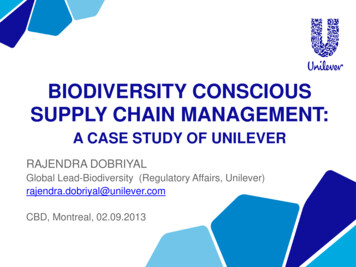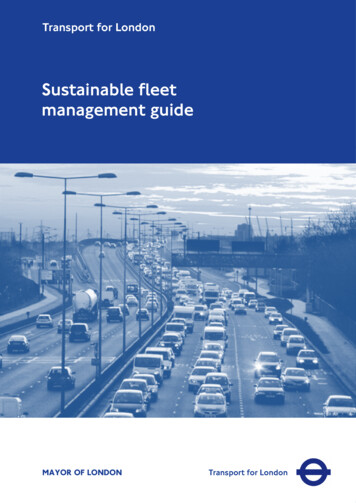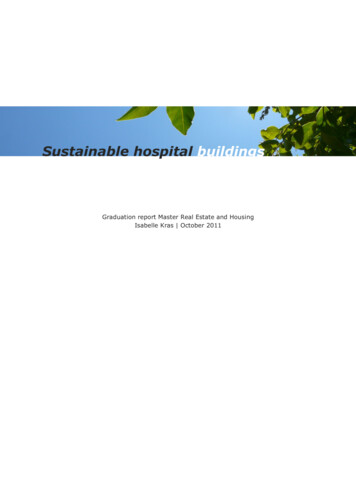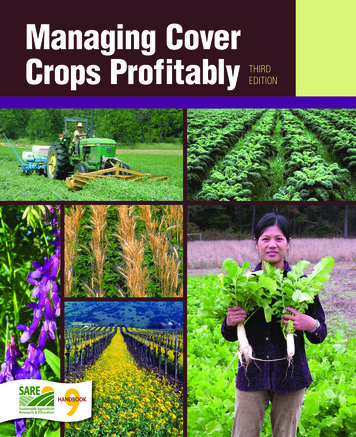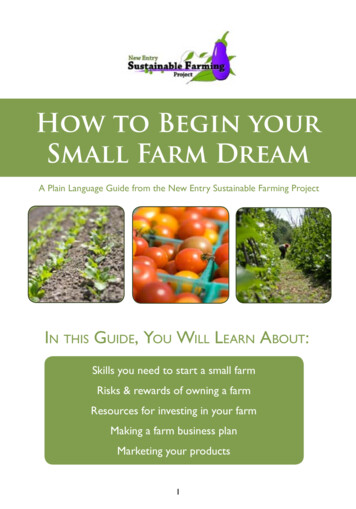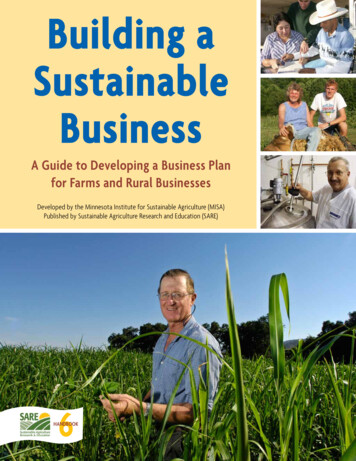
Transcription
Building aSustainableBusinessA Guide to Developing a Business Planfor Farms and Rural BusinessesDeveloped by the Minnesota Institute for Sustainable Agriculture (MISA)Published by Sustainable Agriculture Research and Education (SARE)6Handbook
HandbookSeriesBook 6Building aSustainable BusinessA Guide to Developing aBusiness Plan for Farms andRural BusinessesDeveloped by:the Minnesota Institute for Sustainable AgricultureSaint Paul, MNPublished by:Sustainable Agriculture Research and Education (SARE)College Park, MD
Project CoordinatorsGigi DiGiacomo, Economic ConsultantDebra Elias Morse, ConsultantRobert King, University of MinnesotaThis publication was developed by the Minnesota Institute forSustainable Agriculture in cooperation with the Center for FarmFinancial Management, with funding from the Minnesota StateLegislature.AuthorsGigi DiGiacomo, Economic ConsultantRobert King, University of MinnesotaDale Nordquist, University of MinnesotaThis publication was co-published by the Sustainable AgricultureResearch and Education (SARE) program, under a cooperative agreement with USDA’s National Institute of Food andAgriculture (NIFA).ContributorsVern Eidman, University of MinnesotaDebra Elias Morse, ConsultantSusan McAllister, Marketing ConsultantKenneth Thomas, Professor Emeritus, University ofMinnesotaTo order copies of this book ( 17.00 plus 6.95 shipping andhandling), contact: (301) 779-1007, sarepubs@sare.org or visit theSARE WebStore at www.sare.org/WebStore; or contact (800)909-6472, or misamail@umn.edu. This publication can be viewedonline at www.misa.umn.edu or at www.sare.org/business.Farmer Business Plan Participants and ReviewersNancy AspelundMabel BreljeMary Doerr, Dancing Winds FarmsFrank Foltz, Northwind Nursery and OrchardsDave and Florence Minar, Cedar Summit FarmGreg Reynolds, Riverbend FarmSecond printing 2006Third printing 2010Fourth printing 2013Fifth printing 2018Copyright 2003, Minnesota Institute for Sustainable AgricultureLibrary of Congress Cataloging In Publication DataBuilding a sustainable business : a guide to developing a business planTechnical ReviewerDamona Doye, Oklahoma State UniversityEditorBeth Nelson, Minnesota Institute for Sustainable AgricultureProductionNancy Goodman, copy editorAndy Zieminski, cover designJim Kiehne, layoutValerie Berton, SARE OutreachFront cover photos by (clockwise from upper right): Jerry DeWitt;Jerry DeWitt; courtesy Florence Minar; Neil Michel. Back cover photos by(from left to right): courtesy John Mayne; courtesy Karl Kupers;Jerry DeWitt; Jerry DeWitt; Mac Martin2BUILDING A SUSTAINABLE BUSINESSfor farms and rural businesses / by the Minnesota Institute forSustainable Agriculture.p. cm. – (Sustainable Agriculture Network handbook series ; bk. 6)Includes bibliographical references.ISBN 1-888626-07-0 (pbk.)1. Farm management. I. Minnesota Institute for Sustainable Agriculture.II. Sustainable Agriculture Network. III. Series.S561.B84 2003630’.68–dc212003005514The SARE program provides information to everyone, without regard to race,religion, national origin, sex, age, disability, familial or veteran status. Every efforthas been made to make this publication as complete and as accurate as possible.It is only a guide, however, and should be used in conjunction with other information sources and in consultation with other financial and production experts.The editors/authors and publisher disclaim any liability, loss or risk, personal orotherwise, which is incurred as a consequence, directly or indirectly, of the useand application of any of the contents of this publication. Mention, visual representation or inferred reference of a product, service, manufacturer or organizationin this publication does not imply endorsement by the USDA, the SARE program,MISA or the authors. Exclusion does not imply a negative evaluation.
Minnesota Institute for Sustainable AgricultureThis publication was developed through the Minnesota Institute for Sustainable Agriculture’s (MISA) SustainableAgriculture Information Exchange program, a clearinghouse of sustainable agriculture information and materials inMinnesota. MISA is a partnership between the University of Minnesota Extension and College of Food, Agriculturaland Natural Resource Sciences and the Sustainers’ Coalition, a group of individuals and community-based, nonprofitorganizations. MISA’s purpose is to bring together the agricultural community and the University community in acooperative effort to develop and promote sustainable agriculture in Minnesota and beyond.Other publications in the Sustainable Agriculture Information Exchange series include:Collaborative Marketing: A Roadmap & Resource Guide for FarmersDairy Your Way: A Guide to Management Alternatives for the Upper MidwestDiscovering Profits in Unlikely Places: Agroforestry Opportunities for Added IncomeHogs Your Way: Choosing a Hog Production System in the Upper MidwestLocal Food: Where to Find It, How to Buy ItMarketing Local FoodMinnesota Guide to Organic CertificationMinnesota Soil Management SeriesPoultry Your Way: A Guide to Management Alternatives for the Upper MidwestResources for Beginning Farmers: Building a Sustainable FutureWhole Farm Planning: Combining Family, Profit, and EnvironmentFor more information on this series, the Information Exchange, or MISA, contact: Minnesota Institute forSustainable Agriculture, 411 Borlaug Hall, 1991 Buford Circle, St. Paul, MN 55108-1013; (612) 625-8235, or tollfree (800) 909-MISA (6472); Fax (612) 625-1268; misamail@umn.edu; www.misa.umn.edu.Center for Farm Financial ManagementThe Center for Farm Financial Management at the University of Minnesota cooperated in the development of thispublication. The Center’s mission is to improve the farm financial management abilities of agricultural producersand the professionals who serve them through educational software and training programs. Contact: Center forFarm Financial Management, University of Minnesota, 130 Ruttan Hall, 1994 Buford Avenue, St. Paul, MN55108; (612) 625-1964 or toll-free (800) 234-1111; cffm@umn.edu; www.cffm.umn.edu.Sustainable Agriculture Research and Education (SARE)SARE is a national grants and outreach program working to advance sustainable innovation to the whole ofAmerican agriculture. SARE is part of USDA’s National Institute of Food and Agriculture (NIFA). For moreinformation about SARE’s grant opportunities and library of books, bulletins and online resources, contact: SAREOutreach, 1122 Patapsco Building, University of Maryland, College Park, MD 20742-6715; phone (301) 405-7955;fax (301) 405-7711; info@sare.org; www.sare.org. Funding for this project was approved by the Minnesota State Legislature and the Energy and SustainableAgriculture Program of the Minnesota Department of Agriculture.BUILDING A SUSTAINABLE BUSINESS3
PrefaceBusiness planning is an important part of owning and managing a farm.Producers traditionally go through the business planning process to: Evaluate production alternatives;Identify new market opportunities; andCommunicate their ideas to lenders, business partners and family.As agricultural entrepreneurs define and create themselves away from more“conventional” farming models, business planning has become more importantthan ever.Producers considering innovative management practices and immaturemarkets use business plans to map out strategies for taking advantage of newopportunities such as organic farming, on-farm processing, direct marketing andrural tourism. A business plan helps producers demonstrate that they have fullyresearched their proposed alternative; they know how to produce their product,how to sell what they produce, and how to manage financial risk.“Building a Sustainable Business: A Guide to Developing a Business Plan forFarms and Rural Businesses” was conceived in 1996 by a planning team for theMinnesota Institute for Sustainable Agriculture (MISA), to address the evolvingbusiness planning needs of beginning and experienced rural entrepre neurs.From the onset, the planning team envisioned a truly useful guidebook thatwould be relevant to the alternative farm operations and rural businesses oftoday. There are certainly more detailed business planning, strategy building,succession planning, marketing and financial planning resources available.It was not our intention to replace these materials. Many of these existingresources are listed in an extensive “Resources” section at the end of thisGuide. Instead, our objective was to compile information from all availableresources, including farmers and other business experts, that could be used tocreate a business planning primer—a guide that will help today’s alternativeagriculture entrepreneurs work through the planning process and to begindeveloping their business plans.This Guide was developed over a period of seven years by a team ofUniversity of Minnesota faculty and staff, individual farmers and consultants.Six farmers developed business plans using the draft materials. This Guideincorporates recommendations on content, language and organization from4BUILDING A SUSTAINABLE BUSINESS
the farmers as well as examples from five of the review team’s businessplans. We are grateful to them for their willingness to share their businessplanning efforts. This Guide was originally targeted toward Upper Midwestproducers and entrepreneurs, hence the “Resources” section is weighted towardMidwest organizations. As the project evolved, we realized that the materialis applicable to a variety of operations throughout the United States; the basicbusiness planning process is universal. The Sustainable Agricultural Researchand Education (SARE) Outreach agreed that this information should reach anational audience and graciously agreed to co-publish this material. This Guidebenefited greatly from a careful review by Damona Doye, Extension Economist,Oklahoma State University, and we are grateful for her suggested revisions.Parallel to the development of this Guidebook, a business planning softwarepackage was developed by the Center for Farm Financial Management at theUniversity of Minnesota. This Guide and software are complementary.Ultimately, this Guide is as much about the planning process as it is aboutthe creation of a final business plan. MISA followed one of the farm reviewerfamilies, Cedar Summit Farm owners Dave and Florence Minar and their family,throughout their planning process. The Minars’ planning experience—theirinitial exploration of values, brainstorming of goals, and research into on-farmmilk processing, markets and financing—is incorporated throughout thisGuide’s text and Worksheets. A completed business plan for the Minars’ CedarSummit Creamery is attached in Appendix A. This enabled us to “put a face” onthe business planning process, and we thank the Minars for their openness insharing so much of their story. Armed with their business plan, the Minars wereable to obtain financing. We are happy to report that as we go to press, CedarSummit Creamery is up and running.We hope this Business Planning Guide will assist today’s alternative andtraditional business owners alike with the creation of a holistic business planrooted firmly in personal, community, economic and environmental values. Witha business plan in hand, today’s farmers and rural entrepreneurs will be able totake that first step toward the creation of a successful and sustainable business.2010 Update. Prior to a 2010 reprinting of the Guide, we updated theResources section. We also caught up with the Minars and provide an updateon Cedar Summit Creamery on page 243.BUILDING A SUSTAINABLE BUSINESS5
Table of ContentsIntroduction. . . . . . . . . . . . . . . . . . . . . . . . . . . . . . . . . . . . . . . . . . . . . . . . . . . . . . . . . . . . . . . . . . . . . . . . . . . . . . . . . . . . . . . . . . . . . 11Structure of This Guide. . . . . . . . . . . . . . . . . . . . . . . . . . . . . . . . . . . . . . . . . . . . . . . . . . . . . . . . . . . . . . . . . . . . . . . . . . . . . . . . . . . . . . . . . .Using This Guide . . . . . . . . . . . . . . . . . . . . . . . . . . . . . . . . . . . . . . . . . . . . . . . . . . . . . . . . . . . . . . . . . . . . . . . . . . . . . . . . . . . . . . . . . . . . . . .Before You Begin: Why Develop a Business Plan and Who Should Be Involved in the Planning Process?. . . . . . . . . . . . . . . . . .Blank Worksheet. . . . . . . . . . . . . . . . . . . . . . . . . . . . . . . . . . . . . . . . . . . . . . . . . . . . . . . . . . . . . . . . . . . . . . . . . . . . . . . . . . . . . . . . . . . . . . . .12141418The Five Planning Tasks:Task One: Identify Values–What’s Important to You? . . . . . . . . . . . . . . . . . . . . . . . . . . . . . . . . . . . . 19Values: What Are They and How Are They Important to the Planning Process?. . . . . . . . . . . . . . . . . . . . . . . . . . . . . . . . . . . . . . . . . . 19Identify Your Own Values. . . . . . . . . . . . . . . . . . . . . . . . . . . . . . . . . . . . . . . . . . . . . . . . . . . . . . . . . . . . . . . . . . . . . . . . . . . . . . . . . . . . . 20Identify Common Values . . . . . . . . . . . . . . . . . . . . . . . . . . . . . . . . . . . . . . . . . . . . . . . . . . . . . . . . . . . . . . . . . . . . . . . . . . . . . . . . . . . . . 22Preparing the Values Section of Your Business Plan. . . . . . . . . . . . . . . . . . . . . . . . . . . . . . . . . . . . . . . . . . . . . . . . . . . . . . . . . . . . . . . 23Blank Worksheets. . . . . . . . . . . . . . . . . . . . . . . . . . . . . . . . . . . . . . . . . . . . . . . . . . . . . . . . . . . . . . . . . . . . . . . . . . . . . . . . . . . . . . . . . . . . 24-25Task Two: Farm History and Current Situation–What Have You Got?. . . . . . . . . . . . . . . 27A Brief History of Your Business. . . . . . . . . . . . . . . . . . . . . . . . . . . . . . . . . . . . . . . . . . . . . . . . . . . . . . . . . . . . . . . . . . . . . . . . . . . . . . . . . . 28Assess Your Current Situation. . . . . . . . . . . . . . . . . . . . . . . . . . . . . . . . . . . . . . . . . . . . . . . . . . . . . . . . . . . . . . . . . . . . . . . . . . . . . . . . . . . . 30Marketing Situation . . . . . . . . . . . . . . . . . . . . . . . . . . . . . . . . . . . . . . . . . . . . . . . . . . . . . . . . . . . . . . . . . . . . . . . . . . . . . . . . . . . . . . . . . . 30Product: What is our product? . . . . . . . . . . . . . . . . . . . . . . . . . . . . . . . . . . . . . . . . . . . . . . . . . . . . . . . . . . . . . . . . . . . . . . . . . . . . . 32Customers: What markets do we serve? . . . . . . . . . . . . . . . . . . . . . . . . . . . . . . . . . . . . . . . . . . . . . . . . . . . . . . . . . . . . . . . . . . . . 32Unique Features: What are the unique features that distinguish our products? . . . . . . . . . . . . . . . . . . . . . . . . . . . . . . . . . . . . 33Distribution: How do we distribute our products? . . . . . . . . . . . . . . . . . . . . . . . . . . . . . . . . . . . . . . . . . . . . . . . . . . . . . . . . . . . . . 34Pricing: How do we price our products? . . . . . . . . . . . . . . . . . . . . . . . . . . . . . . . . . . . . . . . . . . . . . . . . . . . . . . . . . . . . . . . . . . . . . 35Promotion: How do we promote our products? . . . . . . . . . . . . . . . . . . . . . . . . . . . . . . . . . . . . . . . . . . . . . . . . . . . . . . . . . . . . . . 37Market and Industry: How is our market changing? . . . . . . . . . . . . . . . . . . . . . . . . . . . . . . . . . . . . . . . . . . . . . . . . . . . . . . . . . . . . 38Operations Situation . . . . . . . . . . . . . . . . . . . . . . . . . . . . . . . . . . . . . . . . . . . . . . . . . . . . . . . . . . . . . . . . . . . . . . . . . . . . . . . . . . . . . . . . . 38What physical resources are available for our farm business? . . . . . . . . . . . . . . . . . . . . . . . . . . . . . . . . . . . . . . . . . . . . . . . . . . . . 39What production systems are we using? . . . . . . . . . . . . . . . . . . . . . . . . . . . . . . . . . . . . . . . . . . . . . . . . . . . . . . . . . . . . . . . . . . . . . 43What management and management information systems do we have in placeto support our farm operations? . . . . . . . . . . . . . . . . . . . . . . . . . . . . . . . . . . . . . . . . . . . . . . . . . . . . . . . . . . . . . . . . . . . . . . . . . 46Human Resources Situation. . . . . . . . . . . . . . . . . . . . . . . . . . . . . . . . . . . . . . . . . . . . . . . . . . . . . . . . . . . . . . . . . . . . . . . . . . . . . . . . . . . . 46Current Work Force: Who is involved in our business and what roles do they play? . . . . . . . . . . . . . . . . . . . . . . . . . . . . . . . 47Skills: What are our unique skills? What skills do we lack? . . . . . . . . . . . . . . . . . . . . . . . . . . . . . . . . . . . . . . . . . . . . . . . . . . . . . . 48Change: Will our labor situation change in the near future? Will someone enter or leave the operation? . . . . . . . . . . . . . . 49Financial Situation . . . . . . . . . . . . . . . . . . . . . . . . . . . . . . . . . . . . . . . . . . . . . . . . . . . . . . . . . . . . . . . . . . . . . . . . . . . . . . . . . . . . . . . . . . . . 51Financial Needs: What are our current family living expenses?. . . . . . . . . . . . . . . . . . . . . . . . . . . . . . . . . . . . . . . . . . . . . . . . . . . 51Financial Performance: How well has our business performed in the past, andhow strong is our current financial position? . . . . . . . . . . . . . . . . . . . . . . . . . . . . . . . . . . . . . . . . . . . . . . . . . . . . . . . . . . . . . . . 52Risk: To what type of risk is the business exposed? . . . . . . . . . . . . . . . . . . . . . . . . . . . . . . . . . . . . . . . . . . . . . . . . . . . . . . . . . . . 61Financial Environment: What is our current business environment and how is it changing? . . . . . . . . . . . . . . . . . . . . . . . . . . 62Whole Farm SWOT Analysis. . . . . . . . . . . . . . . . . . . . . . . . . . . . . . . . . . . . . . . . . . . . . . . . . . . . . . . . . . . . . . . . . . . . . . . . . . . . . . . . . . . . . 64Prepare the History and Current Situation Section of Your Business Plan. . . . . . . . . . . . . . . . . . . . . . . . . . . . . . . . . . . . . . . . . . . . . . . 66Blank Worksheets. . . . . . . . . . . . . . . . . . . . . . . . . . . . . . . . . . . . . . . . . . . . . . . . . . . . . . . . . . . . . . . . . . . . . . . . . . . . . . . . . . . . . . . . . . . . 67-86Task Three: Vision, Mission and Goals–Where Do You Want to Go?. . . . . . . . . . . . . . . . . . 87Dream a Future Vision. . . . . . . . . . . . . . . . . . . . . . . . . . . . . . . . . . . . . . . . . . . . . . . . . . . . . . . . . . . . . . . . . . . . . . . . . . . . . . . . . . . . . . . . . . .Develop a Mission Statement. . . . . . . . . . . . . . . . . . . . . . . . . . . . . . . . . . . . . . . . . . . . . . . . . . . . . . . . . . . . . . . . . . . . . . . . . . . . . . . . . . . . .Set and Prioritize Goals. . . . . . . . . . . . . . . . . . . . . . . . . . . . . . . . . . . . . . . . . . . . . . . . . . . . . . . . . . . . . . . . . . . . . . . . . . . . . . . . . . . . . . . . . .What Are Goals? . . . . . . . . . . . . . . . . . . . . . . . . . . . . . . . . . . . . . . . . . . . . . . . . . . . . . . . . . . . . . . . . . . . . . . . . . . . . . . . . . . . . . . . . . . . .6BUILDING A SUSTAINABLE BUSINESS88909191
Write Out Goals. . . . . . . . . . . . . . . . . . . . . . . . . . . . . . . . . . . . . . . . . . . . . . . . . . . . . . . . . . . . . . . . . . . . . . . . . . . . . . . . . . . . . . . . . 94Identify Common Goals. . . . . . . . . . . . . . . . . . . . . . . . . . . . . . . . . . . . . . . . . . . . . . . . . . . . . . . . . . . . . . . . . . . . . . . . . . . . . . . . . . . 94Prioritize Goals. . . . . . . . . . . . . . . . . . . . . . . . . . . . . . . . . . . . . . . . . . . . . . . . . . . . . . . . . . . . . . . . . . . . . . . . . . . . . . . . . . . . . . . . . . . 95Prepare the Vision, Mission and Goals Section of Your Business Plan. . . . . . . . . . . . . . . . . . . . . . . . . . . . . . . . . . . . . . . . . . . . . . . . . . . 96Blank Worksheets. . . . . . . . . . . . . . . . . . . . . . . . . . . . . . . . . . . . . . . . . . . . . . . . . . . . . . . . . . . . . . . . . . . . . . . . . . . . . . . . . . . . . . . . . . . 97-101Task Four: Strategic Planning and Evaluation–What RoutesCan You Take to Get Where You Want to Go?. . . . . . . . . . . . . . . . . . . . . . . . . . . . . . . . . . . . . . . . . . . 103Develop a Business Strategy. . . . . . . . . . . . . . . . . . . . . . . . . . . . . . . . . . . . . . . . . . . . . . . . . . . . . . . . . . . . . . . . . . . . . . . . . . . . . . . . . . . . . 106Marketing Strategy. . . . . . . . . . . . . . . . . . . . . . . . . . . . . . . . . . . . . . . . . . . . . . . . . . . . . . . . . . . . . . . . . . . . . . . . . . . . . . . . . . . . . . . . . . . 106Markets: Who are our target customers and what do they value? . . . . . . . . . . . . . . . . . . . . . . . . . . . . . . . . . . . . . . . . . . . . . . 108—Segmentation—Sales potentialProduct: What product will we offer and how is it unique? . . . . . . . . . . . . . . . . . . . . . . . . . . . . . . . . . . . . . . . . . . . . . . . . . . . . 112Competition: Who are our competitors and how will we position ourselves?. . . . . . . . . . . . . . . . . . . . . . . . . . . . . . . . . . . . 114Distribution and Packaging: How and when will we move our product to market?. . . . . . . . . . . . . . . . . . . . . . . . . . . . . . . . . 115—Scope—Movement—Packaging—Delivery scheduling and handlingPricing: How will we price our product? . . . . . . . . . . . . . . . . . . . . . . . . . . . . . . . . . . . . . . . . . . . . . . . . . . . . . . . . . . . . . . . . . . . . 121Promotion: How and what will we communicate to our buyers or customers? . . . . . . . . . . . . . . . . . . . . . . . . . . . . . . . . . . . 126—Image or product—Message—Tools and delivery—Timing and frequency—CostsInventory and Storage Management: How will we store inventory and maintain product quality? . . . . . . . . . . . . . . . . . . . . 131Develop a Strategic Marketing Plan. . . . . . . . . . . . . . . . . . . . . . . . . . . . . . . . . . . . . . . . . . . . . . . . . . . . . . . . . . . . . . . . . . . . . . . . . 132Operations Strategy. . . . . . . . . . . . . . . . . . . . . . . . . . . . . . . . . . . . . . . . . . . . . . . . . . . . . . . . . . . . . . . . . . . . . . . . . . . . . . . . . . . . . . . . . 134Production and Management: How will we produce? . . . . . . . . . . . . . . . . . . . . . . . . . . . . . . . . . . . . . . . . . . . . . . . . . . . . . . . . . 134—Production system—Production scheduleRegulations and Policy: What institutional requirements exist?. . . . . . . . . . . . . . . . . . . . . . . . . . . . . . . . . . . . . . . . . . . . . . . . . . . 137Resource Needs: What are our physical resource needs?. . . . . . . . . . . . . . . . . . . . . . . . . . . . . . . . . . . . . . . . . . . . . . . . . . . . . . 138Resource Gaps: How will we fill physical resource gaps?. . . . . . . . . . . . . . . . . . . . . . . . . . . . . . . . . . . . . . . . . . . . . . . . . . . . . . . 139—Land and buildings—Machinery and equipmentSize and Capacity: How much can we produce?. . . . . . . . . . . . . . . . . . . . . . . . . . . . . . . . . . . . . . . . . . . . . . . . . . . . . . . . . . . . . . 143Develop a Strategic Operations Plan. . . . . . . . . . . . . . . . . . . . . . . . . . . . . . . . . . . . . . . . . . . . . . . . . . . . . . . . . . . . . . . . . . . . . . . . 144Human Resources Strategy. . . . . . . . . . . . . . . . . . . . . . . . . . . . . . . . . . . . . . . . . . . . . . . . . . . . . . . . . . . . . . . . . . . . . . . . . . . . . . . . . . . 145Labor Needs: What are our future workforce needs?. . . . . . . . . . . . . . . . . . . . . . . . . . . . . . . . . . . . . . . . . . . . . . . . . . . . . . . . . 146—Tasks—WorkloadSkills: What skills will be required to fill workforce needs? . . . . . . . . . . . . . . . . . . . . . . . . . . . . . . . . . . . . . . . . . . . . . . . . . . . . . 148Gaps: How will we fill workforce gaps? . . . . . . . . . . . . . . . . . . . . . . . . . . . . . . . . . . . . . . . . . . . . . . . . . . . . . . . . . . . . . . . . . . . . . 149Compensation: How will we pay family and members of our workforce? . . . . . . . . . . . . . . . . . . . . . . . . . . . . . . . . . . . . . . . . 151Management and Communication: Who will manage the business and how?. . . . . . . . . . . . . . . . . . . . . . . . . . . . . . . . . . . . . 152—Management—CommunicationDevelop a Strategic Human Resource Plan. . . . . . . . . . . . . . . . . . . . . . . . . . . . . . . . . . . . . . . . . . . . . . . . . . . . . . . . . . . . . . . . . . 154Financial Strategy. . . . . . . . . . . . . . . . . . . . . . . . . . . . . . . . . . . . . . . . . . . . . . . . . . . . . . . . . . . . . . . . . . . . . . . . . . . . . . . . . . . . . . . . . . . . 154Risk Management: How will we manage risk?. . . . . . . . . . . . . . . . . . . . . . . . . . . . . . . . . . . . . . . . . . . . . . . . . . . . . . . . . . . . . . . . . 155Organizational Structure: How will we legally organize and structure our business? . . . . . . . . . . . . . . . . . . . . . . . . . . . . . . . . 158Finance: How will we finance capital requirements?. . . . . . . . . . . . . . . . . . . . . . . . . . . . . . . . . . . . . . . . . . . . . . . . . . . . . . . . . . . 160BUILDING A SUSTAINABLE BUSINESS7
Develop a Strategic Financial Plan. . . . . . . . . . . . . . . . . . . . . . . . . . . . . . . . . . . . . . . . . . . . . . . . . . . . . . . . . . . . . . . . . . . . . . . . . . 163Whole Farm Strategy. . . . . . . . . . . . . . . . . . . . . . . . . . . . . . . . . . . . . . . . . . . . . . . . . . . . . . . . . . . . . . . . . . . . . . . . . . . . . . . . . . . . . . . . 164Evaluate Strategic Alternatives. . . . . . . . . . . . . . . . . . . . . . . . . . . . . . . . . . . . . . . . . . . . . . . . . . . . . . . . . . . . . . . . . . . . . . . . . . . . . . . . . . . . 166Long-Term Outlook. . . . . . . . . . . . . . . . . . . . . . . . . . . . . . . . . . . . . . . . . . . . . . . . . . . . . . . . . . . . . . . . . . . . . . . . . . . . . . . . . . . . . . . . . 167Profitability: Will this new strategy significantly increase net income from the farm?. . . . . . . . . . . . . . . . . . . . . . . . . . . . . . . . 168—Enterprise Evaluation for Profitability: Net return and break-evens—Whole Farm Evaluation for Profitability: Partial budgeting and long-range planningLiquidity: Will this new strategy help generate cash flow sufficient to pay back debts in a timely fashion? . . . . . . . . . . . . . 174Solvency: Will this new strategy lead to growth in net worth?. . . . . . . . . . . . . . . . . . . . . . . . . . . . . . . . . . . . . . . . . . . . . . . . . . 175Risk: Will this new strategy affect the risks faced by the farm business and family? . . . . . . . . . . . . . . . . . . . . . . . . . . . . . . . . 176Transition Period Evaluation. . . . . . . . . . . . . . . . . . . . . . . . . . . . . . . . . . . . . . . . . . . . . . . . . . . . . . . . . . . . . . . . . . . . . . . . . . . . . . . . . . 177Choose the Best Whole Farm Strategy. . . . . . . . . . . . . . . . . . . . . . . . . . . . . . . . . . . . . . . . . . . . . . . . . . . . . . . . . . . . . . . . . . . . . . . . . . . . 179Develop a Contingency Plan. . . . . . . . . . . . . . . . . . . . . . . . . . . . . . . . . . . . . . . . . . . . . . . . . . . . . . . . . . . . . . . . . . . . . . . . . . . . . . . . . . . . . 182Prepare the Strategy Section of Your Business Plan. . . . . . . . . . . . . . . . . . . . . . . . . . . . . . . . . . . . . . . . . . . . . . . . . . . . . . . . . . . . . . . . . 184Blank Worksheets. . . . . . . . . . . . . . . . . . . . . . . . . . . . . . . . . . . . . . . . . . . . . . . . . . . . . . . . . . . . . . . . . . . . . . . . . . . . . . . . . . . . . . . . . . 186-231Task Five: Present, Implement and Monitor Your Business Plan–Which RouteWill You Take and How Will You Check Your Progress Along the Way?. . . . . . . . . . . 233Organizing and Writing Your Business Plan. . . . . . . . . . . . . . . . . . . . . . . . . . . . . . . . . . . . . . . . . . . . . . . . . . . . . . . . . . . . . . . . . . . . . . . . 233Implementation and Monitoring. . . . . . . . . . . . . . . . . . . . . . . . . . . . . . . . . . . . . . . . . . . . . . . . . . . . . . . . . . . . . . . . . . . . . . . . . . . . . . . 238Develop an Implementation “To-do” List. . . . . . . . . . . . . . . . . . . . . . . . . . . . . . . . . . . . . . . . . . . . . . . . . . . . . . . . . . . . . . . . . . . . 238Establish Monitoring Checkpoints. . . . . . . . . . . . . . . . . . . . . . . . . . . . . . . . . . . . . . . . . . . . . . . . . . . . . . . . . . . . . . . . . . . . . . . . . . 240Maintain Records . . . . . . . . . . . . . . . . . . . . . . . . . . . . . . . . . . . . . . . . . . . . . . . . . . . . . . . . . . . . . . . . . . . . . . . . . . . . . . . . . . . . . . . . 241Review Progress. . . . . . . . . . . . . . . . . . . . . . . . . . . . . . . . . . . . . . . . . . . . . . . . . . . . . . . . . . . . . . . . . . . . . . . . . . . . . . . . . . . . . . . . . 242Blank worksheets . . . . . . . . . . . . . . . . . . . . . . . . . . . . . . . . . . . . . . . . . . . . . . . . . . . . . . . . . . . . . . . . . . . . . . . . . . . . . . . . . . . . . . . . . . 245-247List of Footnote References. . . . . . . . . . . . . . . . . . . . . . . . . . . . . . . . . . . . . . . . . . . . . . . . . . . . . . . . . . . . . . . . . . . . . . . 248Resources. . . .
A Guide to Developing a Business Plan for Farms and Rural Businesses HA 6 nDBook . MISA is a partnership between the University of Minnesota Extension and College of Food, Agricultural and Natural Resource Sciences and the Sustainers’ Coaliti
